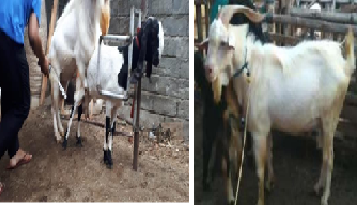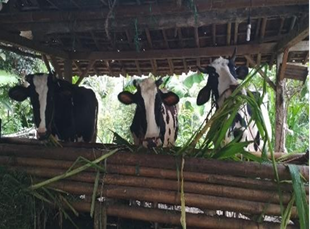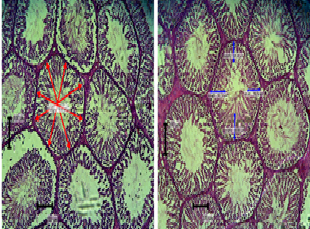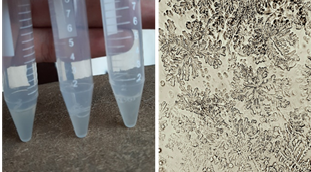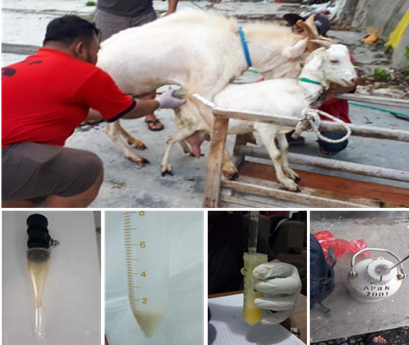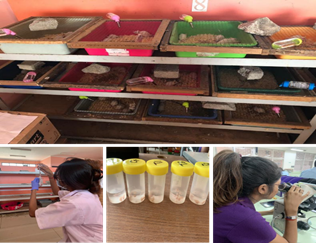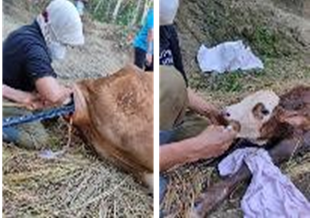Incidence and management of dystocia of dairy cows in Manoharganj upazila of Cumilla district, Bangladesh
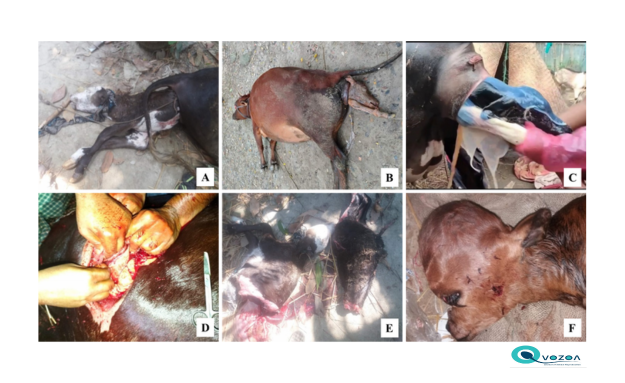
Downloads
Every year, thousands of cows and calves die during parturition for poor parturition managements, and insufficient veterinary services. A total of 83 cases of dystocia were the subject of a retrospective investigation between January 2021 and December 2023 to determine the incidence of dystocia in dairy cows in Manoharganj upazila of Cumilla district, Bangladesh. The study revealed that local breed cows had a higher prevalence of dystocia (53.01%) than cross-breed cows (46.99%). Also, younger cows had a higher incidence of dystocia (71.08%) than older cows. Primiparous heifers showed a higher incidence of dystocia (69.88%) than pluriparous cows (30.12%). In addition, compared with naturally inseminated cows (9.64%), artificially inseminated dairy cows had a higher dystocia rate (90.36%). The occurrence of dystocia was found to occur more frequently in fetal causes (65.06%) than in maternal causes (34.94%). Among maternal causes, incomplete cervix dilation was the most common (18.07%), while fetal head deviation was the most frequent fetal cause (27.71%). Fetal oversize, carpal flexion, shoulder flexion, fetal dropsy, twin calves, uterine torsion, and uterine inertia were other low-incidence causes of dystocia. The most common method of managing dystocia was manual correction (91.57%), followed by fetotomy (4.82%), and C-section (3.61%). After dystocia treatment, 96.25% of dams survived, and 3.75% of cases resulted in dam deaths; fetal death occurred in 32.5% of cases, while the fetal survival rate was 67.5%. Therefore, this study suggest that when using artificial insemination, it is best to consider the breed of the dam and sire.
Abera D. 2017. Management of dystocia cases in the cattle: A review. J Reprod Infertil. 8: 1-9.
Arthur GH. 1966. Recent advances in bovine obstetrics. Vet Rec. 79: 630-40.
Atashi H, Asaadi A, Hostens M. 2021. Association between age at first calving and lactation performance, lactation curve, calving interval, calf birth weight, and dystocia in Holstein dairy cows. PloS one 16: e0244825.
Augustine R, Bintara S, Andarwati S, Muzayyanah MA, Widi TS, Putra AR. 2019. Analysis in making decision of farmer to select bull frozen semen in Indonesia. J Indones Trop Anim Agric. 44: 323-32.
Bhattacharyya HK, Bhat FA, Buchoo BA. 2015. Prevalence of dystocia in sheep and goats: a study of 70 cases (2004-2011). J Adv Vet Res. 5: 14-20.
Bhattcharyya HK, Fazili MR, Buchoo BA, Akand AH. 2012. Genital prolapse in crossbred cows: prevalence, clinical picture and management by a modififi ed Bühner’s technique using infusion (drip) set tubing as suture material. Vet Arh. 82: 11-24.
Bicalho RC, Galvão KN, Warnick LD, Guard CL. 2008. Stillbirth parturition reduces milk production in Holstein cows. Prev Vet Med. 84: 112-20.
De Amicis I, Veronesi MC, Robbe D, Gloria A, Carluccio A. 2018. Prevalence, causes, resolution and consequences of bovine dystocia in Italy. Theriogenology 107: 104-8.
Febrianila R, Paramita LW, Imam RT, Mustofa I, Safitri E, Hermadi HA. 2021. Kasus distokia pada sapi potong di kecamatan kunir kabupaten lumajang tahun 2015 dan 2016. Ovozoa: J Anim. Reprod. 7: 148-51.
Frame N. 2006. Management of dystocia in cattle. In Pract. 8: 470-6.
Gaafar HM, Shamiah SM, El-Hamd MA, Shitta AA, El-Din MT. 2011. Dystocia in Friesian cows and its effects on postpartum reproductive performance and milk production. Trop Anim Health Prod. 43: 229-34.
Jackson PG. 2004. Handbook of veterinary obstetrics. 2nd Ed. Saunders Edinburgh, UK. 141-66.
Jackson PGG. 1980. Handbook of Veterinary Obstetrics. WB Saunders Company Limited, London. 221.
Juneja R, Jhamb D, Gaur M, Sharma SK, Sain A. 2023. A retrospective study on causes of dystocia in cattle and buffaloes at referral centre in South Rajasthan. Indian J Vet Sci Biotechnol. 19: 104-6.
Khan MR, Uddin J, Gofur MR. 2015. Effect of age, parity and breed on conception rate and number of service per conception in artificially inseminated cows. Age (year). Bangladesh Livest J. 1: 1: 1-4.
Kolkman I, De Vliegher S, Hoflack G, Van Aert M, Laureyns J, Lips D, De Kruif A, Opsomer G. 2017. Protocol of the caesarean section as performed in daily bovine practice in Belgium. Reprod Domest Anim. 42: 583-9.
Lestari NAA, Ulva DM, Ulum MF. 2019. Penanganan distokia karena schistosomus reflexus pada sapi friesian holstein. ARSHI Vet Lett. 3: 9-10.
Linde-Forsberg C, Eneroth A. 2000. Abnormalities in pregnancy, parturition and the periparturient period. In: Ettinger SJ, Feldman EC (Eds). Textbook of Veterinary Internal Medicine. 5th Ed. Saunders, Philadelphia, USA. 1527-39.
Lombard JE, Garry FB, Tomlinson SM, Garber LP. 2007. Impacts of dystocia on health and survival of dairy calves. J Dairy Sci. 90: 1751-60.
McGuirk BJ, Forsyth R, Dobson H. 2007. Economic cost of difficult calvings in the United Kingdom dairy herd. Vet Rec. 161: 685-7.
Mee JF, Berry DP, Cromie AR. 2011. Risk factors for calving assistance and dystocia in pasture-based Holstein-Friesian heifers and cows in Ireland. Vet J. 187: 189-94.
Mee JF. 2008. Prevalence and risk factors for dystocia in dairy cattle: A review. Vet J. 176: 93-101.
Mekonnen M, Moges N. 2016. A review on dystocia in cows. Eur J Biol Sci 8: 91-100.
Nanda AS, Brar PS, Prabhakar S. 2003. Enhancing reproductive performance in dairy buffalo: major constraints and achievements. Reproduction. Reprod Suppl. 61: 27-36.
Noakes DE, Parkinson TJ, England GCW. 2018. Arthur's veterinary reproduction and obstetrics. 10th Ed. Elsevier Health Sciences.
Paputungan U, Utiah W, Turangan S, Ngangi LR, Sondakh EH. 2022. Kemudahan lahir, bobot sapih dan nilai ekonomi pedet yang dihasilkan dari persilangan breed pejantan berbeda dengan induk sapi breed Bali murni. Zootech. 42: 507-20.
Phogat JB, Bugalia NS, Gupta SL. 1992. Incidence and treatment of various forms of dystocia in buffaloes. Indian J Anim Reprod. 13: 69-70.
Purohit GN, Barolia Y, Shekhar C, Kumar P. 2011. Maternal dystocia in cows and buffaloes: A review. Open J Anim Sci. 1: 41.
Purohit GN, Kumar P, Solanki K, Shekher C, Yadav SP. 2012. Perspectives of fetal dystocia in cattle and buffalo. Vet Sci Dev. 2: e8.
Rahawy MA. 2019. Clinical dystocia in Iraqi buffaloes in Mosul city. Adv Anim Vet Sci. 7: 715-9.
Reshma A, Gudur IH, Shankare Gowda AJ. 2018. A retrospective study of incidence of dystocia in crossbred dairy cows. J Entomol Zool Stud. 6: 660-2.
Singla VK, Gandotra VK, Prabhakar S. 1990. Incidence of various types of dystocias in cows. Indian Vet J. 67: 283-4.
Singla VK, Sharma RD. 1992. Analysis of 188 cases of dystocia in buffaloes. Indian Vet J. 69: 563-4.
Sloss V, Dufty, JH. 1980. Hand book of bovine obstetrics. Williams and Wilkins. Baltimore, USA.
Uzamy C, Kaya I, Ayyilmaz T. 2010. Analysis of risk factors for dystocia in a Turkish Holstein herd. J Anim Vet Adv. 9: 2571-7.
Verma SK, Tyagi RPS, Manohar M. 1974. Caesarean, section in bovine: A clinical study. Indian Vet. J. 51: 471-9.
Weldeyohanes G, Fesseha H. 2020. Dystocia in domestic animals and its management. Int J Phar Biomed Res. 7: 1-11.
Yohannes G, Tesfay A. 2018. Retrospective study of dystocia in dairy cows in Saesie Tsaeda-Emba district, Eastern Tigray, Ethiopia. Int J Avian Wildl Biol. 3: 293-6.
Zaborski D, Grzesiak W, Szatkowska I, Dybus A, Muszynska M, Jedrzejczak M. 2009. Factors affecting dystocia in cattle. Reprod Domest Anim. 44: 540-51.
Copyright (c) 2024 Al Wasef, Md. Rashedul Islam

This work is licensed under a Creative Commons Attribution-ShareAlike 4.0 International License.
Ovozoa by Unair is licensed under a Creative Commons Attribution-ShareAlike 4.0 International License.
1. The journal allows the author to hold the copyright of the article without restrictions.
2. The journal allows the author(s) to retain publishing rights without restrictions
3. The legal formal aspect of journal publication accessibility refers to Creative Commons Attribution Share-Alike (CC BY-SA).
4. The Creative Commons Attribution Share-Alike (CC BY-SA) license allows re-distribution and re-use of a licensed work on the conditions that the creator is appropriately credited and that any derivative work is made available under "the same, similar or a compatible license”. Other than the conditions mentioned above, the editorial board is not responsible for copyright violation.





























